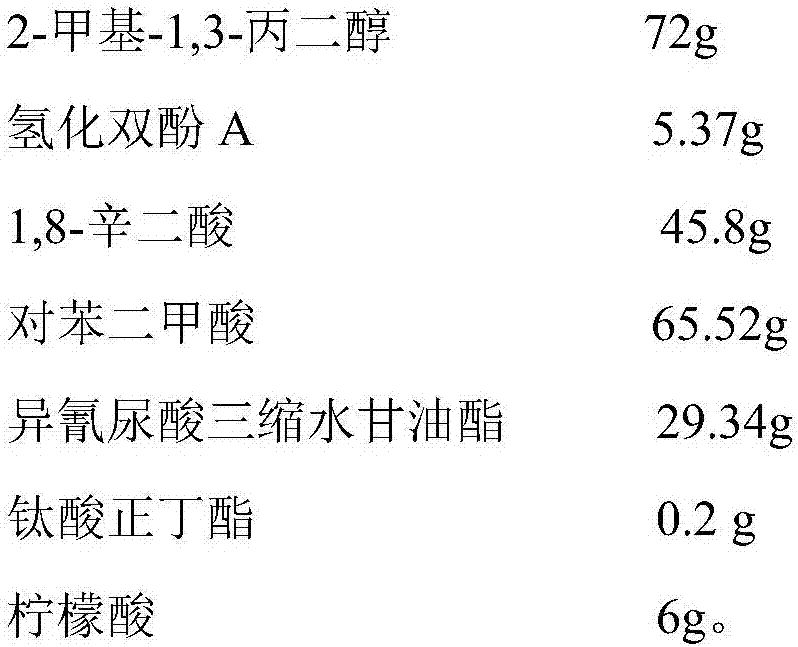Heterocycle modified flexible hydrolysis-resistant polyester and preparation method thereof
A hydrolysis-resistant and flexible technology, applied in polyester coatings, coatings, etc., can solve the problems of polyester flexibility decline, limited raw material types, high cost and other problems
- Summary
- Abstract
- Description
- Claims
- Application Information
AI Technical Summary
Problems solved by technology
Method used
Image
Examples
Embodiment 1
[0084] The heterocyclic modified flexible hydrolysis-resistant polyester provided in this embodiment is mainly prepared by the following method: selecting component A, component B and branched component C in the presence of a catalyst for esterification polycondensation reaction, and then In the later stage of the reaction, component D is added for reaction to obtain a flexible hydrolysis-resistant polyester with a six-membered branched island structure, wherein the proportion of the six-membered branched island structure in the flexible polyester structure is less than or equal to 13%.
[0085] Component A is selected from difunctional carboxylic acids. The secondary or tertiary carboxyl groups in the difunctional carboxylic acid account for no more than 20% of the total moles of the carboxylic acid. Component A is a dibasic acid, specifically 1,8-suberic acid With terephthalic acid.
[0086] Component B is selected from bifunctional alcohols. The primary hydroxyl groups in the bi...
Embodiment 2
[0097] The heterocyclic modified flexible hydrolysis-resistant polyester provided in this embodiment is mainly prepared by the following method: selecting component A, component B and branched component C in the presence of a catalyst for esterification polycondensation reaction, and then In the later stage of the reaction, component D is added for reaction to obtain a flexible hydrolysis-resistant polyester with a six-membered branched island structure, wherein the proportion of the six-membered branched island structure in the flexible polyester structure is ≤7%.
[0098] Component A is selected from difunctional carboxylic acids. The secondary or tertiary carboxyl groups in the difunctional carboxylic acid account for no more than 20% of the total moles of carboxylic acid. Component A is a dibasic acid, specifically sebacic acid and isophthalic acid. Formic acid and 1,4-cyclohexanedicarboxylic acid.
[0099] Component B is selected from bifunctional alcohols. The primary hydroxy...
Embodiment 3
[0109] The heterocyclic modified flexible hydrolysis-resistant polyester provided in this embodiment is mainly prepared by the following method: selecting component A, component B and branched component C in the presence of a catalyst for esterification polycondensation reaction, and then In the late stage of the reaction, the component D is added to react to obtain a flexible hydrolysis-resistant polyester with a six-membered branched island structure, wherein the proportion of the six-membered branched island structure in the flexible polyester structure is ≤2%.
[0110] Component A is selected from difunctional carboxylic acids. The secondary or tertiary carboxyl groups in the difunctional carboxylic acid account for no more than 20% of the total moles of carboxylic acid. Component A is a dibasic acid, specifically 1,6-adipic acid And terephthalic acid.
[0111] Component B is selected from bifunctional alcohols. The primary hydroxyl groups in the bifunctional alcohols account f...
PUM
| Property | Measurement | Unit |
|---|---|---|
| Hydroxyl value | aaaaa | aaaaa |
| Glass transition temperature | aaaaa | aaaaa |
| Melt viscosity | aaaaa | aaaaa |
Abstract
Description
Claims
Application Information
 Login to View More
Login to View More - R&D Engineer
- R&D Manager
- IP Professional
- Industry Leading Data Capabilities
- Powerful AI technology
- Patent DNA Extraction
Browse by: Latest US Patents, China's latest patents, Technical Efficacy Thesaurus, Application Domain, Technology Topic, Popular Technical Reports.
© 2024 PatSnap. All rights reserved.Legal|Privacy policy|Modern Slavery Act Transparency Statement|Sitemap|About US| Contact US: help@patsnap.com










